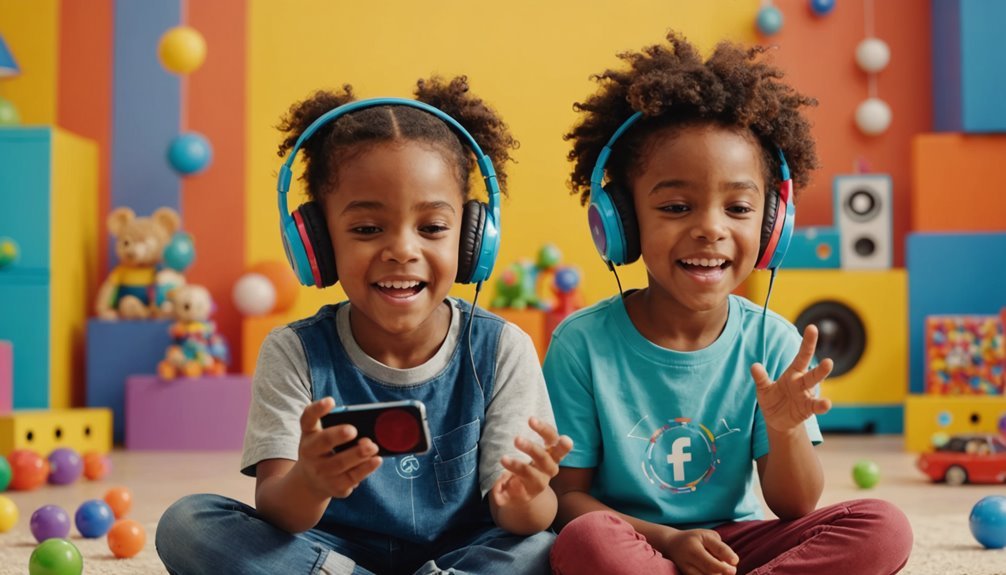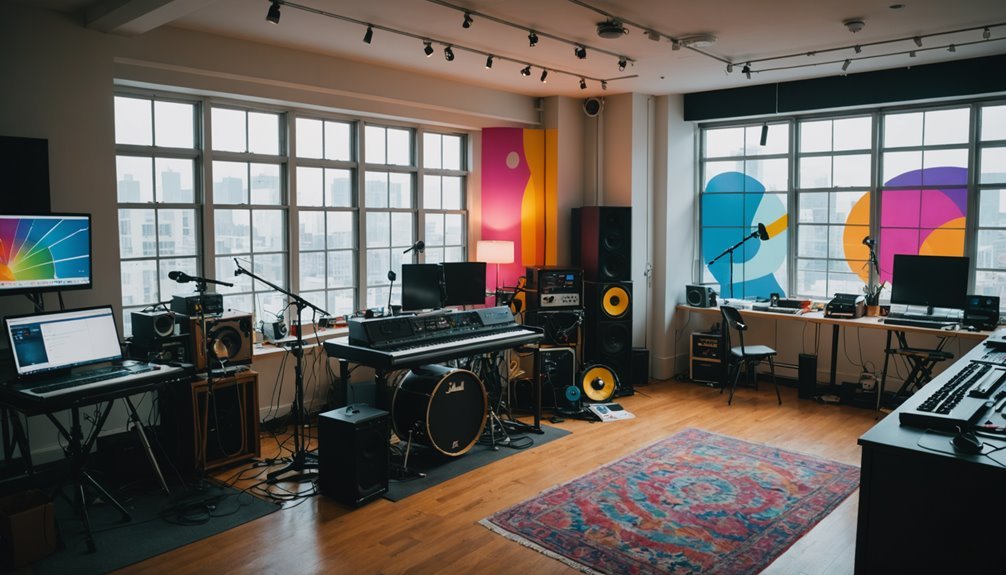Did you know that audio branding in ads can increase brand recognition by up to 46%? Sound plays a huge role in how we remember things. A catchy jingle or a familiar melody can stick in people’s minds long after they’ve scrolled past an ad. Big brands use this strategy to build trust and connection, but small businesses can do it too. Whether it’s a short tune or a signature sound, the right audio can make your brand unforgettable.
One great example of audio branding in ads can be found in Facebook video ads for Airbnb. Their ads often feature soft, inviting music that makes viewers feel at home. That sound choice isn’t random—it’s designed to create warmth and trust, making potential customers more likely to book a stay. Research shows that 74% of people develop a stronger emotional connection to brands that use music that fits their identity. This means the right sounds don’t just make an ad better—they help build lasting relationships with customers.
As a professional jingle writer, I help businesses create unique sounds that make their ads more effective. The good news is, you don’t need a big budget to add audio branding to your marketing strategy. A simple melody, a few spoken words, or a well-placed sound effect can make all the difference. Want to make your brand stand out? Start thinking about how sound can work for you!
Key Takeaways
- Jingles create memorable auditory signatures that enhance brand recall in Facebook and Google ads, fostering emotional connections with consumers.
- Sound design establishes a cohesive sonic identity, improving brand recognition across digital platforms and making campaigns more impactful.
- Catchy melodies and rhythms in ads encourage audience engagement, making it easier for consumers to remember and relate to the brand.
- Emotional resonance from well-crafted audio elements complements visual narratives, creating a more immersive brand experience for viewers.
- Measuring engagement metrics helps brands assess the effectiveness of audio branding, ensuring sound design contributes to campaign success.
The Importance of Audio Branding in Advertising
As consumers navigate a world saturated with visual stimuli, audio branding emerges as a vital element in the advertising landscape, subtly influencing perceptions and feelings. This auditory dimension captivates audiences, creating an immersive experience that transcends mere visuals. By integrating recognizable sounds or melodies, brands foster a sense of familiarity, inviting consumers into a community where shared experiences and memories flourish.
Effective audio branding resonates with listeners, forging emotional connections and enhancing brand recall. It transforms fleeting moments into lasting impressions, solidifying a brand’s identity while reinforcing loyalty. In a marketplace where competition is fierce, audio branding serves as a powerful tool, helping brands not only stand out but also create a sense of belonging among their audience, inviting them to be part of something greater.
Additionally, jingles enhance brand memorability and can significantly impact consumer purchasing decisions.
Understanding Jingles: The Science Behind Catchy Tunes
Jingles serve as brands’ auditory signatures, expertly crafted to etch themselves into consumers’ minds. These catchy tunes utilize the psychology of memory, employing simple melodies and repetitive lyrics to foster familiarity and sentimental connections. The science behind jingles reveals that tunes with a strong hook can trigger dopamine release, creating pleasure that boosts brand recall.
Additionally, the use of rhyme and rhythm not only captivates attention but also encourages sing-alongs, forging a communal experience among listeners. By tapping into cultural references and shared values, jingles resonate deeply, making consumers feel a sense of belonging. Ultimately, effective jingles transcend mere advertising, becoming cherished parts of collective memory and identity.
Furthermore, jingles can boost brand recognition and engagement, solidifying their role as essential marketing tools.
Sound Design: Creating a Sonic Identity for Your Brand

Sound design plays a pivotal role in shaping a brand’s sonic identity, making it crucial for businesses to recognize its importance. By carefully crafting elements such as melodies, tones, and rhythms, brands can create a memorable auditory experience that resonates with their audience. Moreover, maintaining consistency across different channels guarantees that this sonic identity remains cohesive and impactful, reinforcing brand recognition at every touchpoint.
Additionally, auditory cues process faster than visual stimuli, making sound a powerful branding tool.
Importance of Sonic Branding
A brand’s sonic identity acts as an invisible thread, weaving through its marketing efforts to establish a memorable presence in consumers’ minds. This auditory signature fosters connections, improves recall, and shapes sentimental responses.
The importance of sonic branding can be encapsulated in three key points:
- Recognition: Unique sounds create familiarity, ensuring brands stand out in a crowded marketplace.
- Sentiment: Music and sound evoke feelings, forging deeper connections with audiences and fostering loyalty.
- Engagement: Well-crafted audio elements improve consumer interaction, making experiences more immersive and enjoyable.
In a world where consumers seek belonging, sonic branding serves as a bridge, inviting them to connect not just with products but with the essence of the brand itself. Additionally, catchy jingles have been shown to influence brand perception and purchase intent significantly.
Elements of Effective Sound
Crafting a sonic identity involves a nuanced blend of elements that resonate with audiences on multiple levels. Effective sound design begins with melody—catchy and memorable tunes that evoke emotions and foster connection. Rhythm follows, establishing a pulse that can energize or soothe, guiding listeners through the brand experience.
Texture plays a critical role too; layers of sound create depth and richness, enhancing the comprehensive narrative. Furthermore, sound logos or unique audio signatures serve as auditory fingerprints, instantly recognizable and synonymous with the brand. Together, these elements forge a cohesive sonic identity that invites audiences to engage, fostering a sense of belonging. In an increasingly competitive landscape, the right sound can transform a fleeting moment into a lasting impression.
Moreover, sonic branding enhances brand recognition through sound elements, making it a pivotal component of modern advertising strategies.
Consistency Across Channels
While brands strive to create memorable experiences, guaranteeing consistency across distinct channels in audio branding is paramount. A cohesive sonic identity fosters recognition and strengthens sentimental connections with audiences. To achieve this, brands should focus on three key elements:
- Unified Sonic Elements: Utilize recurring motifs, melodies, or sound logos that resonate across platforms.
- Brand Voice Alignment: Confirm that the tone and style of audio content reflect the comprehensive brand personality, enhancing relatability.
- Cross-Channel Integration: Seamlessly incorporate audio branding in different formats, from social media ads to podcasts, allowing audiences to encounter familiar sounds, regardless of context. Moreover, establishing a unique sonic identity leads to deeper emotional connections, ultimately influencing purchase intent and driving brand loyalty.
Emotional Connection: How Sound Influences Consumer Behavior

Sound possesses a unique power to evoke feelings and shape consumer perceptions, often transcending the visual elements of advertising. Through carefully crafted jingles and soundscapes, brands can tap into listeners’ sentiments, creating a sense of familiarity and connection. These auditory cues foster emotional resonance, making consumers more likely to engage and remember the brand.
Sound can reflect shared values and evoke nostalgia, enhancing the feeling of belonging among target audiences. As consumers navigate an expanse of advertisements, the right sound can cut through the noise, establishing a deeper bond that goes beyond mere recognition. Ultimately, by leveraging audio branding strategically, brands can nurture loyalty and forge lasting relationships with their audiences, making sound an indispensable tool in the marketing arsenal.
Additionally, creating effective jingles involves blending creativity with familiarity to maximize impact.
Integrating Audio Branding in Facebook Ads
As brands navigate the vibrant landscape of Facebook ads, the significance of audio branding emerges as a powerful tool for engagement. Crafting memorable jingles and employing cutting-edge sound design techniques can raise an advertisement from ordinary to unforgettable. By strategically integrating these audio elements, brands can create a sonic identity that resonates deeply with their audience, enhancing recall and sentimental connection.
Memorable Jingle Creation
A catchy jingle can act as a powerful auditory signature for brands, making them instantly recognizable in the crowded landscape of Facebook ads. Memorable jingles create heartfelt connections, fostering a sense of belonging among audiences. To craft an effective jingle, brands should focus on three key elements:
- Simplicity: Keep melodies and lyrics straightforward for easy recall.
- Relevance: Confirm the jingle reflects the brand’s identity and values, resonating with target audiences.
- Catchiness: Use rhythmic patterns and hooks that linger in listeners’ minds, encouraging repeat engagement.
Sound Design Techniques
Crafting a memorable jingle lays the groundwork for effective audio branding, but to fully utilize its potential in Facebook ads, brands must investigate advanced sound design techniques. Integrating layered soundscapes not only improves heartfelt resonance but also fosters a sense of community among listeners. Utilizing Foley sounds can create relatable experiences, immersing the audience in familiar environments.
Furthermore, strategic use of silence can heighten anticipation, making the jingle’s entrance more impactful. Brands should also consider the importance of brand consistency; employing signature sounds throughout their campaigns reinforces identity. By weaving these sound design elements together, brands can cultivate a deeper connection with their audience, transforming casual viewers into loyal advocates, nurturing a sense of belonging in their community.
Leveraging Sound Design in Google Ad Campaigns

Sound design emerges as a powerful tool in Google ad campaigns, engaging audiences and enhancing brand identity. By thoughtfully integrating sound elements, brands can forge deeper connections with their target audience. Here are three distinctive methods for leveraging sound design:
- Signature Sounds: Develop original audio cues that become synonymous with the brand, fostering instant recognition.
- Emotional Resonance: Utilize music and sound effects that evoke specific emotions, aligning with the campaign’s message and creating a memorable experience.
- Contextual Relevance: Tailor sound elements to resonate with the intended audience, ensuring that the auditory experience complements the visual narrative.
Incorporating these strategies allows Google ad campaigns to stand out, fostering a sense of belonging and loyalty among consumers.
Case Studies: Brands That Successfully Utilize Audio Branding
Numerous brands have utilized the power of audio branding to create unforgettable connections with their audiences. For instance, McDonald’s iconic “I’m Lovin’ It” jingle resonates with consumers, evoking feelings of nostalgia and joy. Similarly, Coca-Cola’s use of uplifting melodies in its holiday campaigns fosters a sense of community and celebration.
Meanwhile, Nike’s motivational soundscapes inspire consumers to push their limits, creating a heartfelt bond that extends beyond the product. Apple’s subtle yet unique sound design in their ads invites consumers into a world of innovation and creativity. These case studies illustrate that when brands harmonize their messaging with memorable audio elements, they forge deeper connections, fostering a sense of belonging that keeps consumers coming back time and time again.
Measuring the Impact of Audio Branding on Engagement

As brands increasingly recognize the significance of audio branding, understanding its impact on consumer engagement becomes vital. Effective measurement hinges on three key elements:
- Brand Recall: Auditory cues like jingles improve memory retention, allowing consumers to recall brand messages easily.
- Sentimental Connection: Sound design can evoke feelings, fostering a deeper emotional bond between consumers and brands, which encourages loyalty.
- Engagement Metrics: Analyzing social media interactions, click-through rates, and consumer feedback can quantify how audio elements influence engagement levels.
Future Trends in Audio Branding for Digital Advertising
How will the evolution of technology shape the landscape of audio branding in digital advertising? As brands increasingly utilize artificial intelligence and machine learning, tailored audio experiences will become the standard. Future campaigns may include dynamic jingles that adapt to consumer preferences, fostering a deeper connection.
In addition, the rise of voice-activated devices will require brands to develop audio identities that resonate seamlessly across platforms. The integration of spatial audio will create immersive environments, inviting audiences to engage more fully with brand narratives. As consumers continue to seek genuineness and belonging, brands that prioritize heartfelt resonance through sound design will stand out, creating communities around their distinctive audio signatures in a crowded digital marketplace.
Frequently Asked Questions
How Can Audio Branding in Ads Make My Business More Memorable?
Audio branding in ads helps your business stand out by creating a unique sound that customers instantly recognize. A well-crafted jingle or sound cue can boost recall, build trust, and make your ads more engaging across platforms like Facebook and Google.
Why Should I Invest in Sound for My Ads?
People remember what they hear—music and sound effects can increase brand recall by nearly 50%. A distinct audio identity makes your business more recognizable and builds emotional connections with your audience.
What If I Don’t Have a Big Budget for Custom Music?
You don’t need a huge budget to add sound to your ads. Even simple, well-placed sound effects or a short, catchy melody can make a significant impact without breaking the bank.
How Do I Choose the Right Sound for My Brand?
Think about the emotions you want your audience to feel. Upbeat music can create excitement, while soft, calming tones can build trust—your sound should match your brand’s personality.
Will Sound Still Matter If Most People Watch Ads on Mute?
Yes! While many users scroll with the sound off, the ones who do listen are more likely to engage. Plus, a recognizable jingle or sound cue can strengthen brand recall across all marketing channels.
Conclusion
To summarize, audio branding is a powerful tool that can significantly improve the effectiveness of Facebook and Google ad campaigns. By weaving catchy jingles and thoughtful sound design into their strategies, brands can create strong heartfelt connections with their audiences. For instance, consider a hypothetical campaign for a new beverage that uses a revitalizing jingle to evoke feelings of summer joy; this sound could transform a mere advertisement into an unforgettable experience, driving both engagement and brand loyalty.


Recent Comments